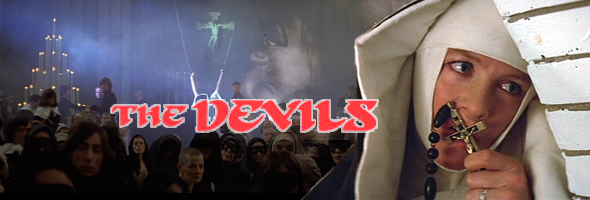
Color, 1971, 111m.
Directed by Ken Russell
Starring Vanessa Redgrave, Oliver Reed, Max Adrian, Gemma Jones, Michael Gothard, Dudley Sutton, Murray Melvin, Georgina Hale, Christopher Logue, Graham Armitage
BFI (DVD) (UK R2 PAL) / WS (2.35:1) (16:9), Warner (DVD) (Spain R2 PAL) / WS (2.35:1)
 Ken Russell's The Devils is not only the director's finest films; it is also one of the greatest works of the 1970s and, as time has proven, one of the pivotal works of British filmmaking and still perhaps the most dangerous title ever released by a major studio. More timely than ever in our age of growing evangelical and political fervor, this is one of those rare films often classified as "horror" (a la Witchfinder General) despite the fact that it contains no monsters, supernatural elements, or mad killers. Instead what we get is an unflinching, fiery gaze into the darkest corners of humanity, and by the time the end credits finally roll, no viewer is left without a scar or two.
Ken Russell's The Devils is not only the director's finest films; it is also one of the greatest works of the 1970s and, as time has proven, one of the pivotal works of British filmmaking and still perhaps the most dangerous title ever released by a major studio. More timely than ever in our age of growing evangelical and political fervor, this is one of those rare films often classified as "horror" (a la Witchfinder General) despite the fact that it contains no monsters, supernatural elements, or mad killers. Instead what we get is an unflinching, fiery gaze into the darkest corners of humanity, and by the time the end credits finally roll, no viewer is left without a scar or two.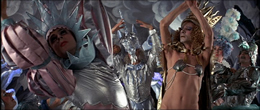 charts the disturbing fate of Loudon, an independent French city surrounded by a fortified wall. Charismatic and sexually active priest Father Grandier (Reed) currently holds sway over the locals and publicly attacks the schemes of Cardinal Richlieu (Logue) and King Louis XIII (Armitage) to steal power over this crucial locale. An opportunity arises for them when fanatical, sexually frustrated, hunchbacked nun Sister Jeanne (Redgrave) develops an obsession with Grandier which, when properly manipulated, turns into wild claims that he's a demonic force infecting all the sisters within the convent. A wild-eyed exorcist, Father Barre (Gothard), is brought in take care of the nuns who are all too willing to go mad and let loose their inhibitions, while a much nastier plan unfolds behind the scenes.
charts the disturbing fate of Loudon, an independent French city surrounded by a fortified wall. Charismatic and sexually active priest Father Grandier (Reed) currently holds sway over the locals and publicly attacks the schemes of Cardinal Richlieu (Logue) and King Louis XIII (Armitage) to steal power over this crucial locale. An opportunity arises for them when fanatical, sexually frustrated, hunchbacked nun Sister Jeanne (Redgrave) develops an obsession with Grandier which, when properly manipulated, turns into wild claims that he's a demonic force infecting all the sisters within the convent. A wild-eyed exorcist, Father Barre (Gothard), is brought in take care of the nuns who are all too willing to go mad and let loose their inhibitions, while a much nastier plan unfolds behind the scenes.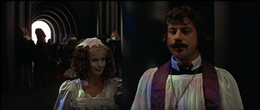 Scream Again and the assassin Roger Moore kicks off a cliff in For Your Eyes Only) steals all of his scenes as a very dangerous religious fanatic. David Watkin's beautiful scope cinematography, Peter Maxwell Davies' deliberately abrasive and abstract score, and Shirley Russell's striking costumes are just a few more of the perfect elements here, creating a whole even greater than the sum of its already formidable parts.
Scream Again and the assassin Roger Moore kicks off a cliff in For Your Eyes Only) steals all of his scenes as a very dangerous religious fanatic. David Watkin's beautiful scope cinematography, Peter Maxwell Davies' deliberately abrasive and abstract score, and Shirley Russell's striking costumes are just a few more of the perfect elements here, creating a whole even greater than the sum of its already formidable parts. 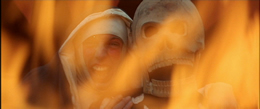 film (though Russell did assemble a 2004 personal edition for video projection which made a few fleeting public appearances), along with a brief, twisted coda to Sister Jeanne's final scene involving a significant human bone. The longest version ever officially released was the first run British edition, which clocked in at 111 minutes; however, the American brass at Warner Brothers was appalled by the film and demanded numerous cuts, including the wholesale removal of every shot of pubic hair. Now running up to eight minutes shorter in most prints, this version was still slapped with an X rating in the U.S., and public response on both sides of the pond included numerous protests and the expected harsh response from many critics (including the most bizarre review Roger Ebert ever wrote). It probably didn't help that the film opened in the middle of the infamous bloody year of 1971, bookended by other controversial films like A Clockwork Orange, Straw Dogs, Dirty Harry, and Macbeth, among others. It really says something that among all those films, this is the one that still provokes the most outrage and sends censors into a frenzy. On a less reputable note, Russell's film also inaugurated an unexpected wave of nunsploitation films (due in no small part to its stormy but very successful release in Italy), which poured out throughout the '70s and even inspired a Jess Franco semi-imitation, The Demons.
film (though Russell did assemble a 2004 personal edition for video projection which made a few fleeting public appearances), along with a brief, twisted coda to Sister Jeanne's final scene involving a significant human bone. The longest version ever officially released was the first run British edition, which clocked in at 111 minutes; however, the American brass at Warner Brothers was appalled by the film and demanded numerous cuts, including the wholesale removal of every shot of pubic hair. Now running up to eight minutes shorter in most prints, this version was still slapped with an X rating in the U.S., and public response on both sides of the pond included numerous protests and the expected harsh response from many critics (including the most bizarre review Roger Ebert ever wrote). It probably didn't help that the film opened in the middle of the infamous bloody year of 1971, bookended by other controversial films like A Clockwork Orange, Straw Dogs, Dirty Harry, and Macbeth, among others. It really says something that among all those films, this is the one that still provokes the most outrage and sends censors into a frenzy. On a less reputable note, Russell's film also inaugurated an unexpected wave of nunsploitation films (due in no small part to its stormy but very successful release in Italy), which poured out throughout the '70s and even inspired a Jess Franco semi-imitation, The Demons.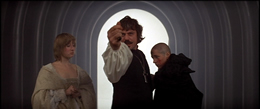 Kermode and featuring interviews with many of the primary living participants including Redgrave, Russell, and much of the supporting cast. This not only boosted the film's status even further but finally offered the first (and only sanctioned) public view of the Rape of Christ scene in its entirety, for the initial airing only. What was most fascinating about this discovery was not the nature of the content itself (which is pretty strong but certainly not as graphic as reports suggested) but its crucial status as the visual link in Russell's filmography to the orgiastic editing rhythms found in Mahler and particularly Tommy (especially the Acid Queen sequence). It also intercut beautifully with Grandier's "communion" in the Lake District, a powerful juxtaposition of a pure gesture of faith against the corruption by false men of the cloth occurring at the same time.
Kermode and featuring interviews with many of the primary living participants including Redgrave, Russell, and much of the supporting cast. This not only boosted the film's status even further but finally offered the first (and only sanctioned) public view of the Rape of Christ scene in its entirety, for the initial airing only. What was most fascinating about this discovery was not the nature of the content itself (which is pretty strong but certainly not as graphic as reports suggested) but its crucial status as the visual link in Russell's filmography to the orgiastic editing rhythms found in Mahler and particularly Tommy (especially the Acid Queen sequence). It also intercut beautifully with Grandier's "communion" in the Lake District, a powerful juxtaposition of a pure gesture of faith against the corruption by false men of the cloth occurring at the same time. 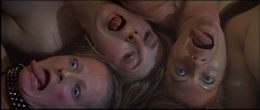 hopefully in all of our lifetimes), this release is a real gift to Russellphiles. First of all, this is a major first as it's the only time the much, much longer British cut (111 minutes, or 107 minutes here in PAL) has ever been available on DVD, and it's the only time in the world it's ever been released in scope. The nasty highlights most viewers outside the UK never got to see (the extended leg torture, the filthy nun and candle shot, etc.) are all here and intact in glorious widescreen at last. This is a major upgrade in every respect for the film, and the image quality is excellent, about as good as standard def will allow; it appears to be from the same excellent source that provided the now-elusive UK print that once made the rounds in the last decade. Optional English subtitles are included, and the film can also be played with a video intro by Kermode explaining the version you're about to see and the late Russell's feelings about how he'd like it to be seen. The first disc also includes both the British and American theatrical trailers (the former more racy than the latter) and one terrific extra, the 26-minute "Amelia and the Angel." This 1959 short was one of Russell's earliest works (just a couple of years after his quirky "Peepshow") and was shot silent, with narration and an oddball score added after the fact. It's a nifty little story filled with freewheeling camera work as a young girl named Amelia loses her angel wings she swiped at a school play and chases them across town, even when they wind up attached to the back of a trained dog named Rocky running through an abandoned train station. Eventually she finds an unlikely source of inspiration and redemption in the form of an "angel," of course.
hopefully in all of our lifetimes), this release is a real gift to Russellphiles. First of all, this is a major first as it's the only time the much, much longer British cut (111 minutes, or 107 minutes here in PAL) has ever been available on DVD, and it's the only time in the world it's ever been released in scope. The nasty highlights most viewers outside the UK never got to see (the extended leg torture, the filthy nun and candle shot, etc.) are all here and intact in glorious widescreen at last. This is a major upgrade in every respect for the film, and the image quality is excellent, about as good as standard def will allow; it appears to be from the same excellent source that provided the now-elusive UK print that once made the rounds in the last decade. Optional English subtitles are included, and the film can also be played with a video intro by Kermode explaining the version you're about to see and the late Russell's feelings about how he'd like it to be seen. The first disc also includes both the British and American theatrical trailers (the former more racy than the latter) and one terrific extra, the 26-minute "Amelia and the Angel." This 1959 short was one of Russell's earliest works (just a couple of years after his quirky "Peepshow") and was shot silent, with narration and an oddball score added after the fact. It's a nifty little story filled with freewheeling camera work as a young girl named Amelia loses her angel wings she swiped at a school play and chases them across town, even when they wind up attached to the back of a trained dog named Rocky running through an abandoned train station. Eventually she finds an unlikely source of inspiration and redemption in the form of an "angel," of course. 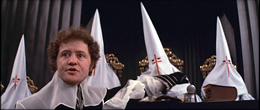 mold, and the onetime popularity of doll enemas.
mold, and the onetime popularity of doll enemas.